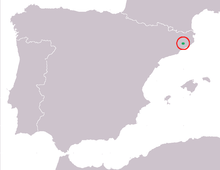Montseny brook newt
| Montseny brook newt | |
|---|---|
 | |
| Scientific classification | |
| Kingdom: | Animalia |
| Phylum: | Chordata |
| Class: | Amphibia |
| Order: | Urodela |
| Family: | Salamandridae |
| Genus: | Calotriton |
| Species: | C. arnoldi |
| Binomial name | |
| Calotriton arnoldi Carranza and Amat, 2005[2] | |
 | |
The Montseny brook newt (Catalan: tritó del Montseny), Calotriton arnoldi, is a species of salamander in the family Salamandridae. It is endemic to the Montseny Massif (Catalan Pre-Coastal Range) in northeast Spain.[3] Before it was formally described in 2005, it was mixed with the larger and more widely distributed Pyrenean brook salamander (Calotriton asper, formerly Euproctus asper).[2]
Description
Montseny brook newt males measure 56–59 mm (2.2–2.3 in) and females 57–59 mm (2.2–2.3 in) in snout–vent length. Tail is 34–44 mm (1.3–1.7 in) and the maximum body size is 103 mm (4.1 in). Dorsum is dark, chocolate-coloured. Head is strongly flattened. Body is oval in cross-section and with some dorsoventral compression.[2]
When handled, Montseny brook newts release a whitish, noxious, sticky, and very odorous skin secretion. This is probably a defence mechanism against predators.[2]
Habitat and conservation
Its natural habitats are oligotrophic, cold (under 15°C) fast running rivers; it seems to be a strictly aquatic species. Its population its supposed to be less than 1,500 individuals with an estimated rate of decline of 15% during the last 10 years. The drying out of mountain streams, human alteration of its original habitat and the global warming are threats to this species. Because of this, the International Union for Conservation of Nature (IUCN) lists it as "critically endangered".[1]
References
- 1 2 Salvador Carranza, Iñigo Martínez-Solano (2009). "Calotriton arnoldi". IUCN Red List of Threatened Species. Version 2014.3. International Union for Conservation of Nature. Retrieved 7 March 2015.
- 1 2 3 4 Carranza, S.; Amat, F. (2005). "Taxonomy, biogeography and evolution of Euproctus (Amphibia: Salamandridae), with the resurrection of the genus Calotriton and the description of a new endemic species from the Iberian Peninsula". Zoological Journal of the Linnean Society 145 (4): 555–582. doi:10.1111/j.1096-3642.2005.00197.x.
- ↑ Frost, Darrel R. (2014). "Calotriton arnoldi Carranza and Amat, 2005". Amphibian Species of the World: an Online Reference. Version 6.0. American Museum of Natural History. Retrieved 9 March 2015.
External links
 Media related to Calotriton_arnoldi at Wikimedia Commons
Media related to Calotriton_arnoldi at Wikimedia Commons
| ||||||
| |||||||||||||||||||||

